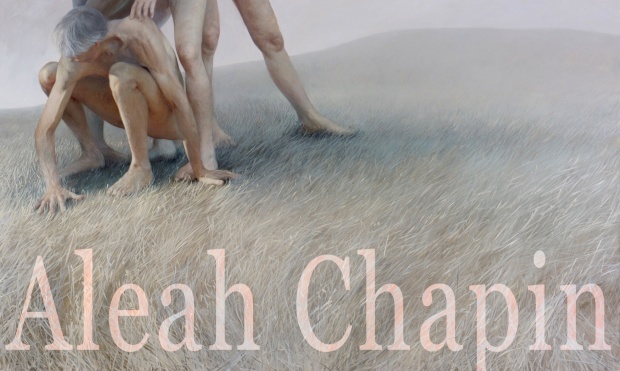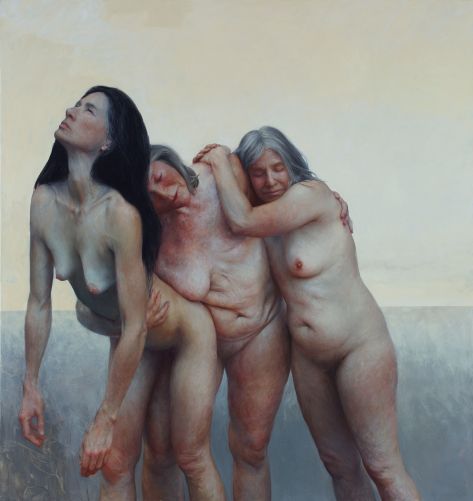This is the 4th interview in looking into the process of high level Realism Artists. When I first saw Aleah’s work, I was probably the most captivated on a personal level. The rawness of her work, and the thoughts that it provoked in me personally were intense. When I first got in touch with Aleah it was great, she was so approachable and lovely about being interviewed, and her responses gave me such an interesting insight into having a framework in your process but also being able to let go of control, not to micromanage the technique to avoid losing the character and energy of the subject.
So without further ado, here is the wonderful Aleah Chapin;
My first question to you is pretty straight forward: What is it that drove you to realism? and what keeps you doing what you do?
I’ve been obsessed with realism since I can remember. There was always this kind of “magic” to it, this fascination that raw materials on a flat surface could breath and live and seem to exist in a world just like ours. And the fact that someone actually created this illusion with their own hands, spending hours pouring over something that so many people wouldn’t even look at; it gives the subject a certain specialness. When creating something inspired by the world outside of you, the possibilities are endless. No two faces are the same because the very essence of life is that it is constantly changing. What keeps me going is this never-ending exploration into possibilities of beauty.
How do you go about developing your ideas for your pieces? Do you have a method for inspiration or is it more like “something pops into your head suddenly”?
I sense something before I see it, and then I go search for it. I’ll gather a group of people together, or sometimes just one person, and take a series of hundreds of photographs. I guide them a bit, but what I really want is to capture those intricate emotions that are not forced, but rather are unaffected reactions to external or internal influences. Photography for me has become a way of sketching. I “sketch” until I recognize that thing I was looking for.
Is there someone else’s work that you can always return to for inspiration?
There are a few. Painters like Jenny Saville and Vincent Desiderio, but also photographers, Sally Mann and Emmet Gowin and sculptor Ron Mueck. I love all these artists because of how they depict the subtleties in a human life.
What are your thoughts on conceptual art and it’s value? What about the conceptual art process?
What I love about conceptual art is that it asks the viewer to think. It isn’t just a pretty picture that gives you everything and can be viewed and quickly forgotten. One of my favorite pieces is Janet Cardiff’s The Forty Part Motet. It’s a blank, sterile room with forty speakers standing in a circle, so when experienced, it looks like anything but art. But each speaker is playing a different voice, singing a part in choir. The music is so beautiful and the room so blank, that it somehow hits the perfect balance of opposites so that each supports the other. So much of the process of conceptual art is the idea of it. In traditional painting, it’s usually the opposite, the “idea” being subservient to the way it is painted. I think that traditional painting has a lot to learn from this way of creating. And on the same note, conceptual art quite often could put more weight on it’s own aesthetic manifestations.
What are your thoughts on the production art industry? and the processes of having an army of artists working on a single project?
Quite simply, I don’t like it. Yes, there are times in the studio that I would love to have help, but in my opinion, most art is primarily a singular vision and should be created that way. It’s that struggle of one person toiling away, obsessing for hours over one object that is so powerful in the final piece. I think there is one exception though, and that is collaborative artists, where the project is recognized and attributed to a group of people. But when one artist is getting the credit for work they don’t even do, it turns it into a commercial commodity.
When it comes to your own artmaking, how much time do you dedicate to the planning process? Is it a conscious effort or do you just go into autopilot?
I plan a bit, but I want the piece to grow through the actual process of its own creation. I will set the boundaries for it, creating a structure, a composition, and then jump right in and see what happens.
When was the Aha or Eureka moment when you realized that you had grasped the ability to paint realistically? Was it a massive breakthrough that made you want to jump up and down? Or was it a natural quiet progression?
I don’t think there was one moment. Painting realistically is something I’ve been obsessed with since I was really young. It comes easier now than it did when I was 4 (although I have a memory of drawing a tree in kindergarten and being like “Wow! It looks like a tree!” which made me very happy) but it’s still quite difficult. I don’t think there has ever been a moment that I have felt like I got it and will always have it. Each painting is a new experience and each one takes an intense amount of pull to get to the point where it feels alive. Every painting will hopefully have its own, quiet Aha moment, but it’s never a guarantee that the next one will have it too.
What was the biggest hurdle you faced when learning art and especially making realistic art?
To let go of control. As realistic artists, we spend our education learning to command every mark. While this is very important, it’s not everything. Once the structure is there, I try and let go and allow the paint and brush to do a lot of the work. Our bodies are completely organic, full of imperfections and beautiful oddities. I’ve learned that the way to paint this is not to obsess over the tiny specifics of those variations, but to try and re-create the personality of them, letting them happen instead of forcing them to happen.
What importance do you place on Realism in the world of art? Why do think it’s still one of the most popular styles?
I think it’s extremely vital and to answer both questions; because it’s a universal language that is easily readable, yet open to a million interpretations.
There are so many artists out there who want to do what you can do — because it’s awesome! For those aspiring to become realistic painters, what is the biggest mistake that you see them making? What do you think are the biggest wastes of time in the earlier stages?
Don’t forget your voice. Don’t let the technique of painting override what you’re trying to say. You may not know what this is yet, but you should always be looking for it. Beautiful painting is all good, we love it, but how much more fun and personally rewarding is it if you really care about what is that you are painting? Don’t underestimate yourself. Take the painting as far as you can, and then take it farther. You have hands and eyes and an imagination, so anything is possible.
And concerning the professional level: What are most common mistakes that you catch yourself and other fellow pros making?
Thinking too much about what other people will think. It’s hard to lock those thoughts out of my studio sometimes, but it’s essential. I know its been said a million times, but the only person you really need to listen to in your studio is yourself. If you are happy with your work, then that is wonderful and really all you need. There will always be people who think your work is bad for one reason or another and it’s so easy to let that voice override your own, but this is crazy if you think about it. Don’t let them rule what you make.
Finally, do you have any strong thoughts or opinions on the public’s perceptions of fine art? Particularly, can you comment on the audience’s common feeling of disconnectedness between a piece and the message behind it?
I think that the reason so much art is disconnected might be because we, as artists, are afraid of seeming too wishy washy and emotional. We want to be taken seriously, prove that we are intellectual and brilliant. I think the outcome of this kind of thinking is often sterile, cold art with every hint of emotion squeezed out of it; no one understands the work, yet everyone feels like they must be the only one to have missed the point. I think we need to stop being scared of showing emotion in art and start creating work from our gut.
For more of Aleah’s amazing work check out her website here: http://aleahchapin.com/








